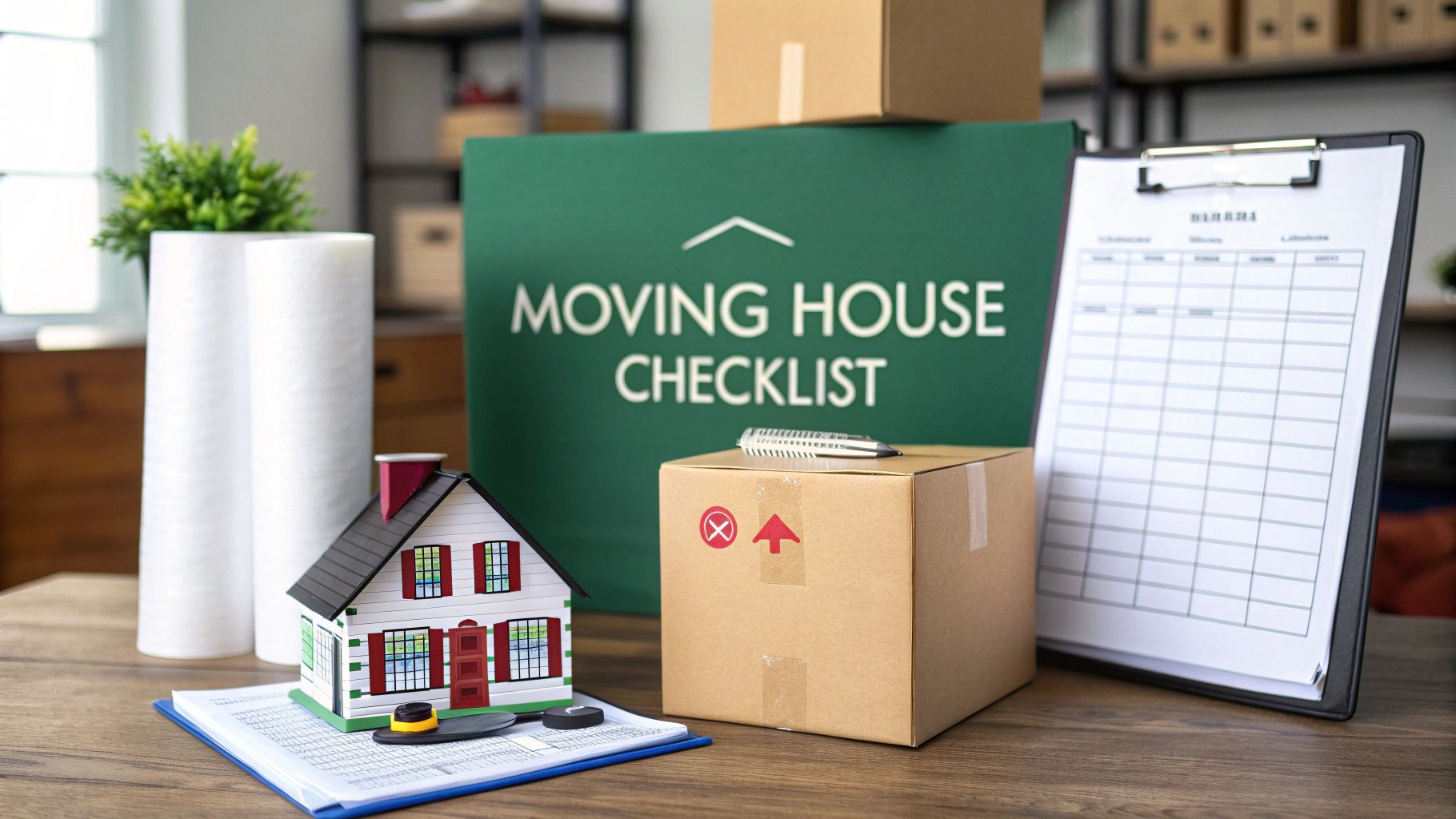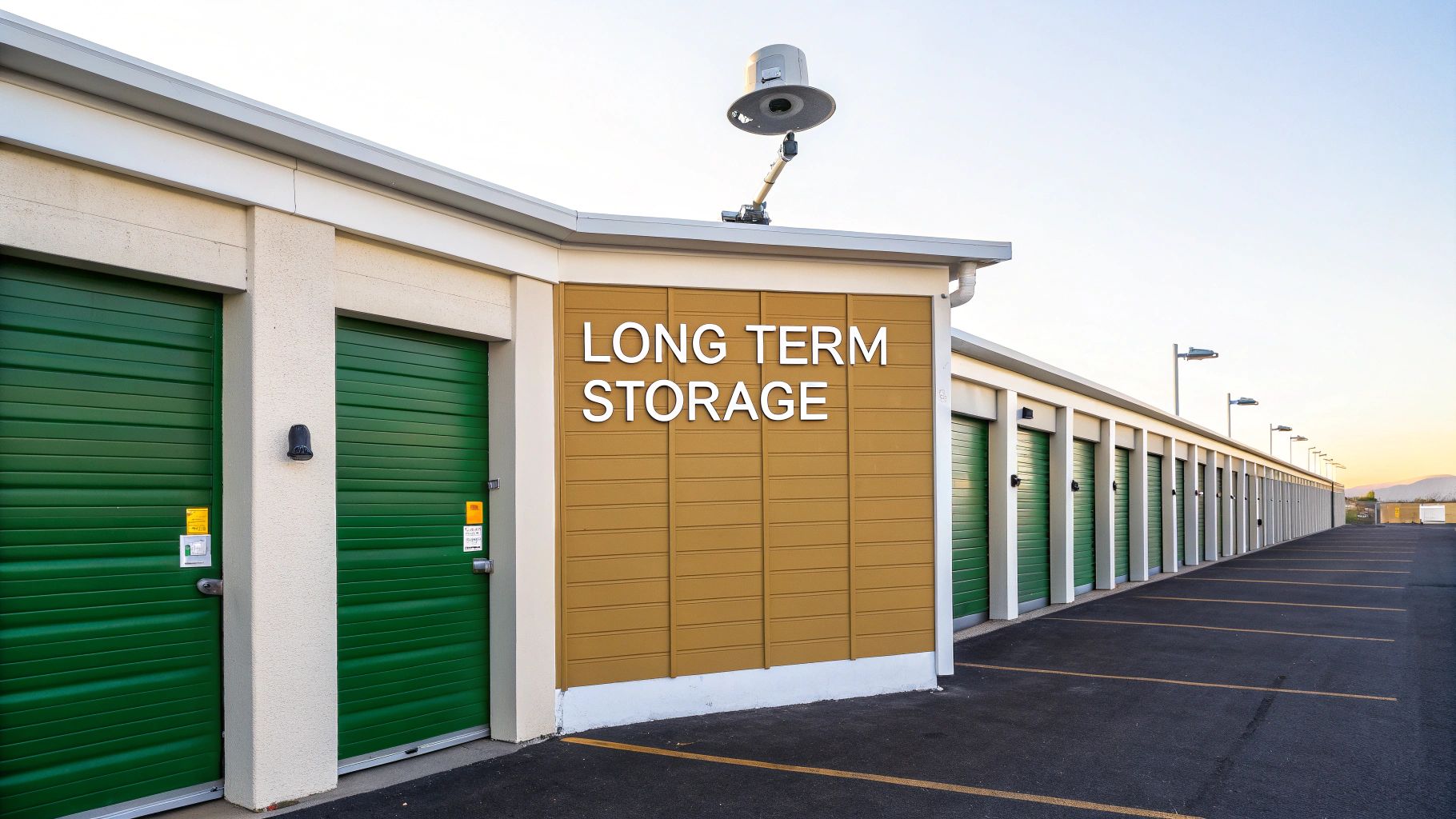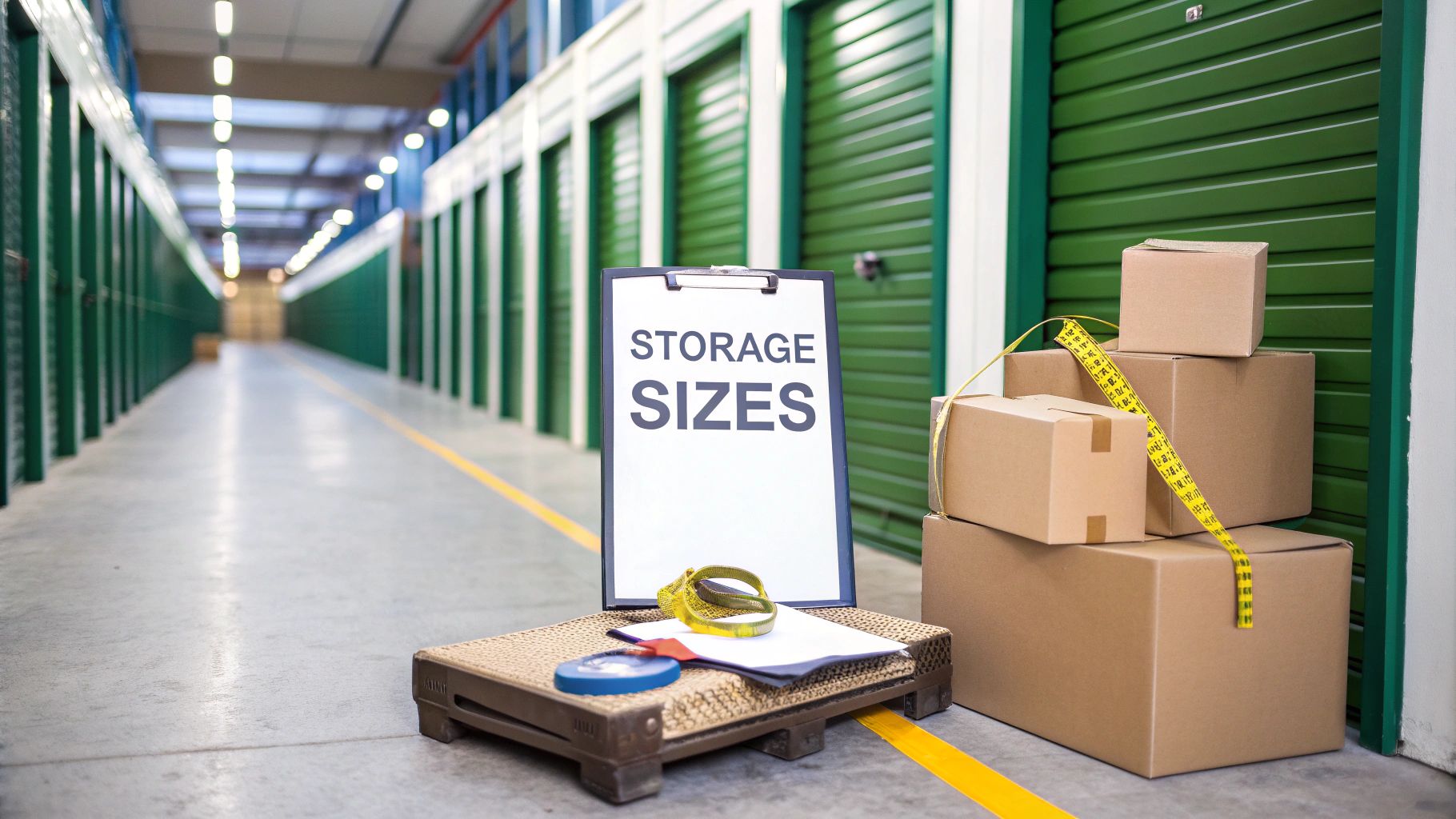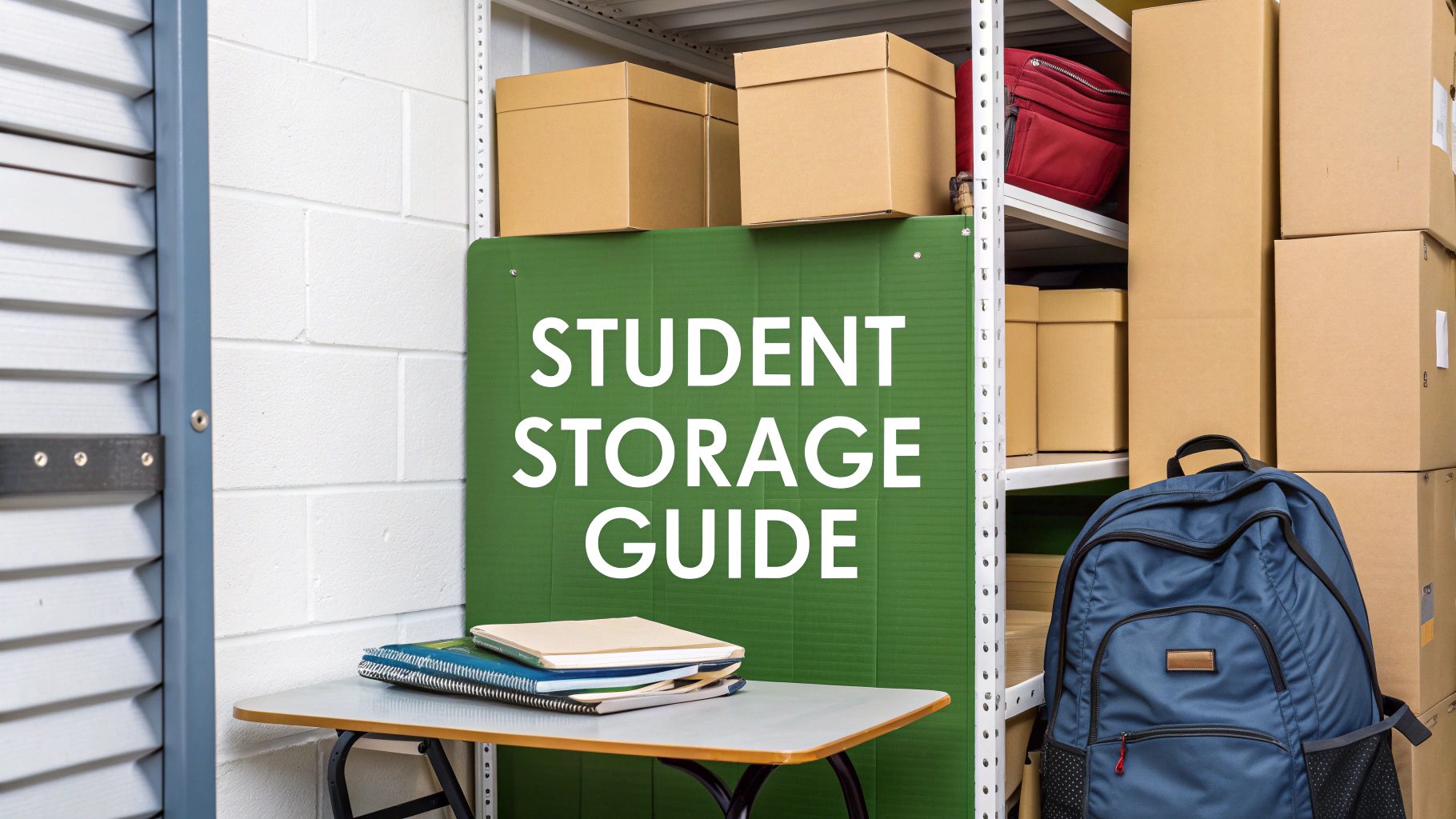Your Ultimate Moving House Checklist for 2025
Moving house is consistently ranked as one of life’s most stressful events, but with meticulous organisation, it doesn't have to be a chaotic ordeal. A well-structured plan can transform a daunting experience into a smooth, manageable transition. This definitive moving house checklist is engineered to guide you through every stage of the process, breaking down the entire journey into actionable, time-based steps. From the initial decision to relocate, right through to the moment you unpack the last box in your new home, we will ensure no critical detail is overlooked.
This comprehensive guide is designed for everyone, from first-time buyers feeling overwhelmed to seasoned homeowners looking for a more efficient system. Our goal is to provide practical advice that helps you maintain complete control over your move. We will cover everything: decluttering your belongings, notifying essential services, packing strategically, and preparing for the logistics of moving day itself. We’ll also highlight how smart planning, including the effective use of self storage, can create valuable breathing room and make all the difference in achieving a calm and organised move. By following this timeline, you can prevent last-minute panic and focus on the excitement of starting a new chapter. For those facing a move across the country, additional planning is crucial. If your move spans a significant distance, you'll appreciate this dedicated resource: Your ultimate long-distance moving checklist for 2025 from ShipCargo. Let's get started on making your next move your easiest one yet.
1. Two Months Before: Declutter, Sort, and Strategise
The foundation of a stress-free move is laid not in the week before, but a full two months in advance. This is the crucial period for a comprehensive decluttering and strategic planning phase, which is a vital first step on any moving house checklist. By tackling this early, you dramatically reduce the volume of belongings you need to pack and transport, which in turn lowers removal costs and simplifies the entire process.
The Four-Box Method
To begin, adopt the highly effective "four-box" method. Label four large boxes or designate four distinct areas in each room: Keep, Sell/Donate, Store, and Bin. Address one room at a time, picking up every single item and making a decisive choice. This systematic approach prevents you from simply shifting clutter from one spot to another.
- Keep: For essential items you use regularly and will need in your new home.
- Sell/Donate: For quality items you no longer need. Photograph items for sale on platforms like Vinted or Facebook Marketplace, and remember to schedule charity collections for larger furniture pieces well in advance, as their calendars fill up quickly.
- Store: For items you don't need immediately but want to keep. This could include seasonal decorations, sentimental items, or furniture that won't fit your new layout right away. Using a self-storage unit is an excellent way to clear space, making packing and home viewings much easier.
- Bin: For items that are broken, expired, or no longer usable.
Strategic Planning for Removals and Storage
This early stage is also the perfect time to research and book your removal company. Reputable firms get booked up months ahead, especially during peak seasons. Simultaneously, assess your storage needs. If you're downsizing, staging your home for sale, or simply want to ease the transition, a storage unit can be invaluable. Don't guess the size you'll require; use an online calculator to get an accurate estimate. For more guidance, you can learn more about choosing the right storage unit size to ensure you only pay for the space you need.
2. Research and Book Moving Company
Once you've organised your belongings, the next critical task on your moving house checklist is securing a reliable removal company. The firm you choose will be responsible for the safe transport of all your worldly goods, making this one of the most significant decisions in the moving process. Starting this research six to eight weeks before your move date gives you ample time to find a trustworthy service without rushing.

Gathering Quotes and Vetting Companies
The key to finding the right partner for your move is thorough research and comparison. Don't simply opt for the first or cheapest quote you receive; a low price can sometimes be a red flag for poor service or hidden fees. Instead, aim to get at least three to five quotes from different companies to get a clear picture of the market rate.
- Check Credentials: Look for membership in trade associations like the British Association of Removers (BAR). This indicates the company adheres to a professional code of practice.
- Read Reviews: Use independent platforms like Google, Trustpilot, or local forums to read recent customer experiences. Pay attention to comments on punctuality, care for belongings, and communication.
- Get a Home Survey: A reputable company will insist on a home survey (either in-person or virtual) to provide an accurate, written quote. Avoid any firm that only offers a vague estimate over the phone.
- Verify Insurance: Ensure the company has comprehensive 'Goods in Transit' and 'Public Liability' insurance. Ask for proof and understand what is covered and what the excess is.
Making the Final Booking
When you've selected your preferred removal company, book them as soon as possible, especially if you are moving during a peak period like summer or at the end of the month. Read the contract carefully before signing, paying close attention to the terms and conditions, cancellation policy, and payment schedule. For more detailed guidance, you can get tips on finding a reliable removal company to ensure your moving day goes as smoothly as possible. A professional, well-vetted team transforms moving day from a stressful ordeal into a streamlined operation.
3. Notify Important Institutions and Services
Once you’ve decluttered and started packing, the next crucial step in your moving house checklist is managing your administrative life. Informing all relevant organisations and service providers of your change of address is essential to ensure a seamless transition. Failing to do so can lead to missed bills, lost important documents, service disruptions at your new property, and even potential identity fraud risks.
Creating Your Notification List
To avoid missing anyone important, create a comprehensive checklist of every person and company that needs your new address. Go through your bank statements and post from the last few months to build a complete list. Organise it into categories to make the task less daunting and more systematic.
- Government & Official Bodies: This includes HMRC for tax purposes, the DVLA for your driving licence and vehicle registration, your local council for council tax, and the Electoral Roll.
- Utilities & Services: Contact your providers for gas, electricity, water, internet, and your mobile phone. You'll need to arrange for final meter readings and either transfer your service or set up a new account.
- Financial Institutions: Inform your bank, building society, credit card companies, pension providers, and any investment or loan companies.
- Health & Insurance: Notify your GP, dentist, optician, and any other healthcare specialists. You must also update your home, car, life, and pet insurance providers to ensure your cover remains valid.
- Subscriptions & Memberships: Don't forget magazine subscriptions, streaming services, gym memberships, and any loyalty schemes you're a part of.
Executing the Notifications
Start contacting these organisations around four weeks before you move. Many providers allow you to update your address online, which is the quickest method. For others, a phone call will be necessary. One of the most important tasks is setting up a mail redirection service with Royal Mail. This service will forward any post sent to your old address to your new one for a set period, acting as a safety net for any notifications you may have missed. Book this at least two weeks before your move day to guarantee it starts on time.
4. Arrange Utilities Setup and Cancellations
Ensuring a seamless transition of essential services is a critical, yet often overlooked, part of any moving house checklist. This stage involves the careful coordination of disconnecting utilities at your old property and activating them at your new home. By managing this four to six weeks before your move, you can prevent unexpected service gaps, avoid being charged for utilities you're no longer using, and walk into a home that is fully functional from day one.
The Utility Transfer Timeline
A systematic approach is essential for a smooth handover. Start by compiling a list of all your current service providers, including electricity, gas, water, council tax, internet, TV, and phone services. Contact each one at least a month in advance to inform them of your moving date and schedule the disconnection or transfer. This lead time is crucial, especially for arranging internet installation, as engineers' schedules can be booked weeks ahead.
- Schedule Disconnections: Arrange for services at your old address to be terminated on the day you hand over the keys. Request a final meter reading to be taken to ensure your final bill is accurate.
- Book New Connections: Schedule the activation of services at your new home for your moving day, or even the day before if possible. There’s nothing worse than arriving late at night to a house with no electricity or heating.
- Document Everything: Keep a detailed record of every call. Note down confirmation numbers, appointment times, and the names of the people you speak to. This digital or physical paper trail can be invaluable if any disputes arise later.
- Return Equipment: Don't forget to arrange the return of any provider-owned equipment, such as internet routers or TV set-top boxes, to avoid hefty non-return fees.
Final Checks and Tidy-Up
In the last week, confirm all your utility appointments. On moving day, take photographs of the final meter readings at your old property as indisputable proof. This simple action can save you from future billing conflicts. As you tackle your final preparations, considering professional move out carpet cleaning can also be a wise investment, helping to leave the property in excellent condition and secure the full return of your security deposit.
5. Update Address with Financial and Insurance Companies
One of the most critical administrative tasks in any moving house checklist is notifying all your financial institutions of your change of address. Failing to do this promptly can lead to missed statements, sensitive documents being sent to the wrong location, and potential security risks. It's a vital step for maintaining accurate records, protecting your credit score, and ensuring uninterrupted service from your banks and insurers.
Systematically Notifying Key Institutions
Start by compiling a comprehensive list of every financial and insurance company you have a relationship with. This systematic approach ensures no account is forgotten. The goal is to inform everyone at least a week before your move date, giving them enough time to update their systems before the next statement cycle.
- Banks and Building Societies: Inform your current account, savings, and ISA providers (e.g., Lloyds, HSBC, Nationwide). This is crucial for receiving new debit cards, PINs, and official correspondence.
- Credit Card Companies: Update your address with issuers like American Express, Visa, and Mastercard. This ensures both your billing and mailing addresses are correct, preventing payment delays.
- Pension and Investment Providers: Notify your pension administrators and investment firms (such as Vanguard or Hargreaves Lansdown) to ensure you receive vital annual statements and portfolio updates.
- Insurance Companies: This is essential. Update your home, contents, car, life, and pet insurance providers. Your new postcode will likely affect your premiums, so it’s important to get an updated and accurate policy in place from the day you move.
- Loan and Mortgage Providers: Inform any companies you have outstanding loans or a mortgage with to ensure all payment information and correspondence are sent to your new home.
A Process for Secure and Confirmed Updates
When updating your details, prioritise security and confirmation. Most providers now offer secure online portals, which are the quickest and most efficient way to change your address. If an online option isn’t available, you may need to call their customer service line or visit a branch in person with proof of your new address, like a council tax bill or utility statement. Always request a written or email confirmation that the change has been made. After your move, double-check the address on the first statement you receive from each provider to verify the update was processed correctly.
6. Pack Systematically Room by Room
Approaching the packing phase without a clear strategy is a recipe for chaos on moving day. A systematic, room-by-room approach transforms this monumental task into a manageable process. This method involves dedicating your focus to one area at a time, ensuring everything is properly categorised, labelled, and documented before you move on, which is an essential part of any comprehensive moving house checklist. This prevents frantic, last-minute searches and makes unpacking logical and efficient.
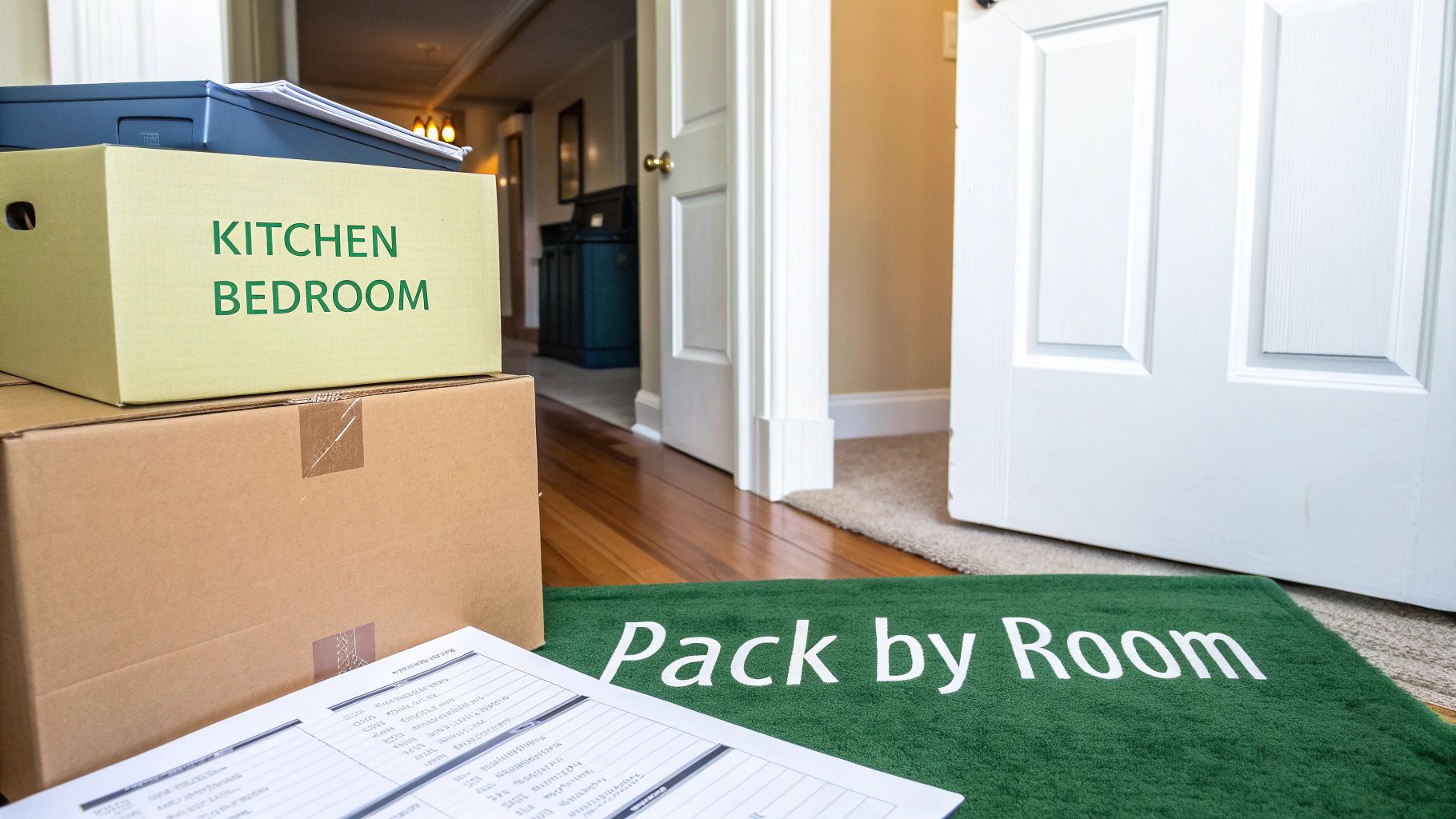
The Inventory and Labelling System
A robust inventory and labelling system is the cornerstone of organised packing. It ensures you know exactly what is in every box and where it should go in your new home. This method saves immense time and reduces the risk of misplacing important items during the move.
- Colour-Code: Assign a specific colour to each room (e.g., blue for the kitchen, red for the master bedroom). Apply coloured tape or stickers to the corresponding boxes. This allows movers to instantly identify where each box belongs without having to read small print.
- Number and List: Number every box sequentially (e.g., Kitchen 1, Kitchen 2). Maintain a corresponding master inventory list or spreadsheet detailing the key contents of each numbered box. For instance, your list might state, "Kitchen 1: Toaster, Kettle, Mugs."
- Label All Sides: Always label boxes on the top and at least two sides. This ensures you can identify the contents regardless of how they are stacked in the removal van or in your new home.
Strategic Packing Implementation
Begin packing non-essential items three to four weeks before your move date. This includes things like out-of-season clothing, guest room linens, books, and decorative items. As you pack, place heavier items in smaller boxes to make them manageable to lift, and fill lighter items in larger boxes. Always fill boxes completely, using packing paper or old towels to fill gaps and prevent the contents from shifting or the box from collapsing. For a detailed breakdown of what to pack and when, you can explore our complete moving house packing checklist to ensure no detail is overlooked.
7. Update Address with Government Agencies
Among the most critical administrative tasks on your moving house checklist is updating your address with all relevant government agencies. This step is not just about convenience; it's a legal requirement that ensures you receive official documents, tax correspondence, driving licence updates, and voter information without interruption. Failing to notify these bodies can lead to missed deadlines, fines, and significant administrative headaches down the line.
Key Agencies to Notify
Start by creating a master list of every official body that holds your address. Prioritising these updates ensures you remain compliant and connected to essential services. This systematic approach will prevent crucial communications from going astray during the transition to your new home.
- HM Revenue & Customs (HMRC): Inform HMRC to ensure your tax records, such as Income Tax and National Insurance, are correct. You can update your address online via your Government Gateway account.
- Driver and Vehicle Licensing Agency (DVLA): You must update the address on your driving licence and vehicle log book (V5C). This is a legal requirement, and failing to do so can result in a fine of up to £1,000. This can be done online and is free of charge.
- Electoral Roll: To ensure you can vote in future elections, you must re-register at your new address. This is easily done through the government's official website and only takes a few minutes.
- Local Council: Notify your current and new local councils. This is essential for finalising your Council Tax bill at your old property and setting it up correctly at your new one.
Action Plan for a Smooth Transition
Timing is crucial when dealing with government departments. Begin the process around two to four weeks before your move, as some changes can take time to be processed. Keep a folder, either physical or digital, with copies of all address change confirmations for your records. Check the specific websites for each agency, as many now offer simple online portals to make these updates, saving you the time and effort of making phone calls or sending letters. This organised approach ensures nothing is missed in the administrative shuffle.
8. Deep Clean Current and New Residences
A thorough clean of both your old and new properties is a non-negotiable step in any comprehensive moving house checklist. This process is not just about tidiness; it’s about financial responsibility and creating a healthy start in your new home. For renters, a professional-standard clean is often essential for securing the full return of your security deposit. For homeowners, it’s a courtesy to the new occupants and a way to ensure your new space is pristine before you unpack.
The Two-Stage Cleaning Strategy
To manage this task effectively, approach it as a two-stage project: the move-out clean and the move-in clean. Scheduling is critical; book professional cleaners for the day after your belongings have been completely removed from your old property. This gives them an empty canvas to work on. Similarly, if possible, arrange for your new home to be cleaned a day or two before your belongings arrive, ensuring every corner is fresh and ready for your furniture.
- Move-Out Clean: This is an intensive, top-to-bottom clean. The goal is to leave the property in the condition you received it, accounting for fair wear and tear. Focus on often-missed areas like skirting boards, inside cupboards, light fittings, and behind appliances.
- Move-In Clean: Even if the previous occupants cleaned, your own deep clean provides peace of mind. This is your opportunity to sanitise surfaces, clean carpets to your standard, and ensure the environment is exactly as you want it before a single box is unpacked.
Protecting Your Deposit and Preparing Your New Home
For your old home, create a detailed checklist and take date-stamped photos of every clean room as evidence for your landlord or the new owners. If hiring professionals, choose a reputable end-of-tenancy cleaning service that understands the specific requirements of letting agents and inventories. Get written quotes detailing exactly what their service includes, from oven cleaning to window washing. For your new residence, prioritising the clean before furniture arrives simplifies the job immensely and ensures you're not living amongst cleaning fumes and equipment during the already stressful unpacking phase.
9. Transfer or Cancel Subscriptions and Memberships
An often-overlooked but financially important task on any moving house checklist is the management of your recurring subscriptions and memberships. Failing to update these services can lead to missed deliveries, service interruptions, or paying for location-specific perks you can no longer use. Taking the time to audit and update these accounts ensures a smooth transition and prevents unnecessary expenses from following you to your new home.
Creating Your Subscription Inventory
The most effective way to tackle this is by creating a comprehensive inventory of every recurring payment. Go through your bank and credit card statements from the past few months and list every subscription and membership, from streaming services like Netflix and Disney+ to physical deliveries such as magazine subscriptions or curated food boxes.
- Categorise: Group them into digital services, physical deliveries, and location-based memberships (like a gym or local club).
- Decide: For each item, decide whether to Transfer, Cancel, or Keep As Is. For example, a gym membership for a national chain like PureGym might be transferable, whereas membership to a local independent gym will need to be cancelled.
- Action: Systematically go through your list. Most services, like Amazon Prime, allow you to update your delivery and billing address directly in your online account settings. For others, a phone call may be necessary.
Why This Audit is Crucial
This process is more than just administrative tidying; it’s a valuable financial health check. You might discover subscriptions you’d completely forgotten about, offering an easy way to cut back on monthly outgoings. It also prevents the frustration of a favourite magazine being delivered to your old address or discovering you've been charged for a gym you can't access. Remember to request and keep a record of any cancellation confirmations, and check your first bank statement after the move to ensure all changes have been correctly processed.
10. Plan and Prepare for Moving Day
With all the preparation complete, the success of the actual move hinges on meticulous day-of planning. This crucial stage in your moving house checklist involves creating a detailed timeline and coordinating all logistical elements to ensure everything unfolds smoothly. A well-orchestrated moving day minimises stress, prevents costly delays, and helps everyone involved, from your family to the removal team, to work efficiently.
Creating a Moving Day Master Plan
Your master plan is a minute-by-minute schedule that outlines the entire day. Start by confirming the arrival time with your removal company 24-48 hours in advance. Your plan should also cover practical logistics, such as arranging childcare or pet care to keep them safe and out of the way during the hustle and bustle. Ensure you have reserved a suitable parking space for the removal lorry, which may require notifying neighbours or arranging a permit with your local council.
- Timeline: Create a clear schedule, e.g., 8am movers arrive, 12pm final check of old property, 2pm key collection, 4pm begin unloading at new home.
- Essential Supplies: Pack an "Open First" box containing essentials like toilet paper, cleaning supplies, phone chargers, a kettle, mugs, and snacks. Keep this box in your car for immediate access.
- Contingency Fund: Have cash on hand for unforeseen expenses or to tip your removal team. A tip of 15-20% of the total bill is customary for excellent service.
- Important Documents: Keep all vital documents, valuables, and medications with you in your personal vehicle, not in the removal lorry.
Final Checks and Handovers
Before you leave your old property for the last time, conduct a thorough final walkthrough. This is your last chance to ensure nothing has been left behind and that the property is in the agreed-upon condition. Take photographic evidence of the final state of the house and record final meter readings for gas, electricity, and water to prevent any future billing disputes. Upon arriving at your new home, take photos of any existing damage before you start moving furniture in to protect your deposit and for your records. A well-documented handover at both ends ensures a clean and professional transition.
10-Point Moving Checklist Comparison
| Item | Implementation complexity | Resource requirements | Expected outcomes | Ideal use cases | Key advantages |
|---|---|---|---|---|---|
| Declutter and Sort Belongings | Moderate — time- and decision-intensive | Time, boxes, disposal/donation logistics | Fewer items to move; lower costs; fresher start | Moves to smaller homes or to reduce moving cost | Reduces volume, saves money, simplifies unpacking |
| Research and Book Moving Company | Moderate — requires comparison and vetting | Budget for quotes, time to research, documentation | Professional handling; reduced damage risk; scheduled service | Long-distance, large moves, limited personal time | Expertise, insurance, saves physical effort |
| Notify Important Institutions and Services | High — many contacts and follow-ups | Time, account lists, verification documents | Continuous service; avoided missed mail or bills | All moves, especially with critical deliveries | Prevents missed documents and service gaps |
| Arrange Utilities Setup and Cancellations | Moderate — scheduling multiple providers | Account info, deposits, appointment windows | Continuous utilities; correct final billing | Moves with tight timelines for service activation | Prevents service gaps and unexpected charges |
| Update Address with Financial and Insurance Companies | Moderate — multiple accounts to update | Secure account access, ID, documentation | Continued statements, valid coverage, fraud reduction | Moves affecting billing or insurance eligibility | Protects finances and maintains coverage validity |
| Pack Systematically Room by Room | Moderate — organisational effort required | Packing materials, labels, inventory system | Easier unpacking; fewer damaged or lost items | Any move, especially multi-room or complex households | Streamlines unpacking; protects belongings |
| Update Address with Government Agencies | High — agency-specific rules and deadlines | Forms, IDs, possible in-person visits | Legal compliance; receipt of official notices | Interstate moves; voting, tax or license changes | Maintains legal records and avoids penalties |
| Deep Clean Current and New Residences | Moderate — physical effort or hired service | Cleaning supplies or paid cleaners, time | Better chance of deposit return; fresh move-in | Rental move-outs; preparing new home for occupancy | Improves inspection outcomes; health/sanitation benefits |
| Transfer or Cancel Subscriptions and Memberships | Low–Moderate — many manual updates | Account logins, time to audit subscriptions | Avoid unexpected charges; maintain needed services | Moves that change service availability or budget | Cost savings; avoids service interruptions |
| Plan and Prepare for Moving Day | High — coordinates many tasks and people | Supplies, contacts, schedule, contingency plans | Smoother move day; fewer delays or lost items | All moves; critical for complex or time-limited moves | Reduces stress, improves efficiency and control |
Your Move, Mastered
Navigating the complexities of relocating can feel like a monumental task, but as this comprehensive moving house checklist demonstrates, it is a challenge that can be conquered with foresight and organisation. The journey from your old front door to your new one isn't about one giant leap; it's a series of deliberate, well-planned steps. By breaking down the process into manageable phases – from the initial decluttering two months out to the final utility checks on moving day – you transform potential chaos into a structured, controllable project.
The true value of a detailed plan lies in its ability to grant you peace of mind. You are no longer reacting to last-minute crises but are proactively managing your transition. Every box labelled, every utility company notified, and every subscription cancelled is a small victory that accumulates, paving the way for a smoother, less stressful experience. This isn't just about moving belongings; it's about moving your life, and that deserves a methodical, thoughtful approach.
Key Takeaways for a Seamless Relocation
Reflecting on the entire process, several core principles stand out as non-negotiable for success:
- Early Action is Everything: The single most impactful thing you can do is start early. Whether it’s researching removal companies, decluttering your loft, or gathering packing supplies, procrastination is the enemy of a calm move. Give yourself the gift of time.
- Systematic Packing Prevails: A room-by-room packing strategy, complete with detailed inventory lists and a clear labelling system, is your best friend. It not only simplifies packing but makes the unpacking process exponentially easier and more organised.
- Administrative Diligence is Crucial: The "unseen" tasks are often the most critical. Diligently notifying everyone from your bank and the DVLA to your local council and streaming services prevents future headaches, from missed post to identity theft risks.
- Embrace Professional Support: Recognise where you need help. This could mean hiring professional cleaners, engaging a reputable removal firm, or utilising a flexible self-storage unit to ease the transition between properties. Investing in support can save you time, physical strain, and significant stress.
A Final Thought: Remember, the ultimate goal is not just to move your possessions but to arrive in your new home ready to embrace the next chapter. A well-executed move allows you to focus on the excitement of a new beginning, rather than the exhaustion of a disorganised departure.
You now possess the framework and the actionable steps required to master your move. This moving house checklist is more than a list of tasks; it is a strategic blueprint for a successful transition. By adopting this phased, organised approach, you are not just hoping for a good move, you are actively engineering one. You are in control, you are prepared, and you are ready to make your next move your best one yet.
Feeling overwhelmed by the sheer volume of your belongings or facing a gap between your move-out and move-in dates? Let MG Self Storage provide the breathing room you need. Our secure, flexible, and accessible storage units are the perfect solution for decluttering before a sale or temporarily housing your possessions during a complicated move. Visit MG Self Storage to discover how we can help simplify your relocation journey.

